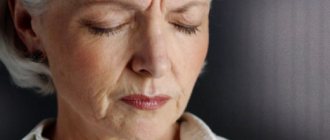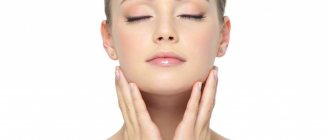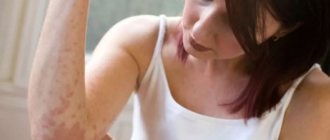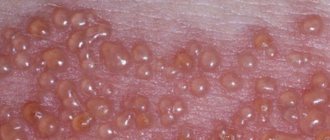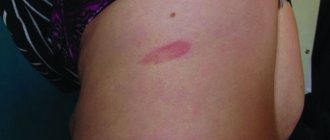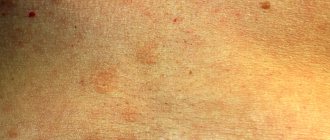- Initial appointment with a dermatologist
1200 ₽ - Calling a dermatologist to your home
4000 ₽
Pityriasis versicolor –
a recurrent disease that affects only the horny surface of the epidermis. The pathology is called “lichen versicolor” because the spots have colors: yellow, whitish, brown. The skin begins to peel off and spots appear in the summer in children and adults. Residents of countries with high humidity and warm climates are susceptible to pathology.
In Russia, skin formations appear in 15% of the population. These are mainly people from 15 to 40 years old, more often observed in men. Children under 7 years of age rarely get shingles. For treatment, contact a dermatologist at our clinic, he will conduct an examination and prescribe medications that will improve the patient’s condition.
Types of pityriasis versicolor:
- Spotty-flaky. During the period of spread, it affects the body in different places: behind the ears, in the groin areas.
- Erythematosquamous. Often observed in adults and children. The rash is beige or coffee-colored, without inflammation. At first the formations are small, but soon they increase in size. This type appears on the head. It worsens in autumn and spring.
- Follicular. Lesions appear on the legs, back, chest, and arms. The spots spread in the hair follicles, their size is up to 3 mm, and itching is observed. This form can form during antibacterial therapy or the use of steroids in people with diabetes.
- Inverted. Characterized by peeling, itching, redness. This species is not common. When the disease occurs, symptoms are not expressed; spots appear on the head.
If you experience formations on the skin, it is better to seek help from qualified specialists at our clinic. Quickly identifying the disease in its early stages will help prevent its spread.
Symptoms in humans
Typical symptoms of pityriasis versicolor in humans are (see photo):
- The appearance of pink spots with a yellowish color;
- A gradual change in their color to brown pigmentation, localized in typical places (primarily the décolleté area);
- Slight fine-plate peeling of rashes that appear on the skin;
- Intermittent itching of the spots, which is not very intense;
- The skin does not tan in the place where the rash is localized. This is explained by the functional inferiority of melanocytes - skin cells that produce pigment.
To determine if you actually have sunburn, visit a dermatologist. The doctor will check your skin with a lamp - the fungus has luminescent properties. If the skin glows pink or greenish-blue, a dermatologist will diagnose lichen.
In humans, the symptoms of pityriasis versicolor, in the form of itching and burning, are often not expressed. If the doctor suspects the presence of a fungal pathogen, he will send the patient for analysis of keratinized skin flakes.
Symptoms of pityriasis versicolor:
- Formation of pink spots. At first they are single, then they increase in size and merge. Rashes are observed on the stomach, neck, under the hair, on the chest.
- As the disease spreads, they become dark in color. May be red or brown. The colors vary on the affected areas, which is why lichen is called tinea versicolor. In some cases, the formations merge into one whole.
- After a certain time, peeling occurs. The scales resemble bran.
- Itching is observed, but not in all cases.
- After healing, white or light spots remain on the skin; tanning does not affect them; this is caused by cell damage as a result of fungi.
What is erythrasma
Erythrasma is a chronic bacterial disease affecting the epidermis layer in the deep folds of the skin. It is characterized by a long course - in some cases, symptoms develop for at least 10 years, without causing significant discomfort to the patient. The clinical picture of erythrasma is similar to a fungal infection of the skin, but modern dermatology classifies it as a group of pseudomycoses.
The following main stages are distinguished in the development of the disease:
- Progression. The first characteristic spots appear on the skin, their size slowly increases, and additional symptoms develop. In some cases, secondary infections occur. The spots gradually merge with each other, forming large areas of damage.
- Stabilization. New spots do not appear, and existing ones stop growing. Peeling of the skin begins. This stage is usually associated with a change in external conditions, for example, cold weather, during which the intensity of sweating decreases and the skin condition stabilizes.
- Exacerbation or relapse. Usually associated with the beginning of the warm season. But in the case of prolonged erythrasma, the disease constantly develops in waves, and after a slight decline its symptoms again actively appear.
- Remission. Occurs with a favorable microclimate, compliance with preventive measures and proper skin care. The color of the affected areas gradually returns to normal, itching and flaking disappear, and the skin is restored.
Without timely, well-chosen treatment, erythrasma can lead to the development of serious complications.
For example, it can provoke eczema and secondary infection in patients with diabetes or obesity. Also, the course of the disease is aggravated by increased humidity and contamination of the affected areas. As a result, its typical symptoms are complicated by burning, itching and pain.
Diagnosis of pityriasis versicolor
The disease is diagnosed by a dermatologist. He performs a visual examination of the patient, studies the presence of spots and their distribution, and makes a diagnosis at this stage. If the form of lichen is not pronounced, then the clinic specialist uses the following methods. Using a Wood's lamp, he makes several tests. After highlighting areas of the skin, they may change color to yellow-red or green.
To clarify the diagnosis, laboratory diagnostics will be required. Specialists using special equipment will be able to detect the presence of the disease after additional research.
Differential diagnosis of pityriasis versicolor with other diseases
To make a diagnosis, the doctor performs the following procedures:
- Conducting an examination under a microscope to determine the scraping. The specialist scrapes the scales from the skin area, processes it and examines it. Using a microscope, it is possible to detect spores and fungi that are round in shape. The mycelium threads are white in color and long in shape, like a thread.
- Balzer test. A 5% iodine solution is used, which is applied to or near the infected areas. This study will take time; the affected skin gradually acquires a different color.
Treatment of pityriasis versicolor
The dermatologist prescribes treatment depending on the nature and form of the disease, the characteristics of the lesion, the age of the patient, and the presence of other pathologies. Applies complex treatment, which includes ointments, sprays, creams, shampoos. They consist of components that effectively affect the disease. Depending on the complexity of the pathology, the patient is prescribed tablets. Therapy will help overcome lichen in a short time and eliminate complications.
For treatment, the doctor prescribes ointments that contain terbinafine. Treatment of the affected skin area is prescribed 2 times a day. This substance quickly destroys microbial cells and eliminates the appearance of new formations. Imidazole, clotrimazole and others are effective for treatment. The substances are included in creams and gels. Tolcyclate and ciclopirox are ointments prescribed to ensure that the pathogens quickly die.
When lichen appears in the hair, the doctor prescribes shampoos containing ketoconazole or nizoral. In the initial stages, patients are recommended salicylic and zinc ointments. The products quickly relieve itching. You should not use medications without consulting a specialist. Qualified doctors of our clinic, using modern equipment, will diagnose and prescribe a course of treatment.
A visit to a dermatologist is necessary 21 days after the prescribed treatment. The doctor will assess the patient’s condition, prescribe additional medications and preventive measures, these include physiotherapy and others.
Reasons for development
Versicolor versicolor is a type of fungal skin infection that affects the stratum corneum of the epidermis and hair follicles. Its causative agents are two types of fungi, and infection is possible only through prolonged and close contact with the patient. And in this case, provoking factors play a big role. These include:
- weakened immunity;
- hyperhidrosis;
- disruption of the sebaceous glands;
- diseases of the endocrine system (obesity, diabetes, Itsenko-Cushing syndrome, etc.);
- hormonal imbalance due to pregnancy, menopause or taking hormone-containing medications;
- vegetative-vascular dystonia;
- abuse of antibacterial personal hygiene products;
- excessive exposure to ultraviolet rays (intense tanning, frequent visits to the solarium) and regular overheating of the body.
It is noteworthy that patients with pityriasis versicolor over 60 years of age are extremely rare. This is due to natural age-related changes in the skin, which make it less susceptible to pathogens.
In children under 10 years of age, the main causes of pityriasis versicolor infection are neglect of personal hygiene rules or improper skin care. At this age, with the protective functions of the skin intact, the body independently copes with pathogenic microorganisms attacking it, so the development of the disease does not occur. But closer to adolescence, when hormonal changes begin, the body’s susceptibility to bacteria, viruses and fungi increases, so children over 10 years old become infected with pityriasis versicolor just like adults.
Prevention of pityriasis versicolor
To reduce the disease, preventive measures play an important role. They include regular washing of skin areas, removal of sweat, sebaceous fat, and regular change of bedding and clothing. In hot weather, antifungal shampoos are an excellent method. They will eliminate the occurrence of relapses. The specialist prescribes products for regular hair washing. As a preventive measure, it will take 5 to 7 days to use the drugs. The skin should be wiped with salicylic alcohol every day.
It is better to wash things not with powders, but with soap, adding soda to the water. You can avoid deprivation; for this you need to strengthen your immune system, eat right, and take vitamins once a year. Experts recommend playing sports and taking walks in the fresh air for treatment. In case of illness, it is recommended to include vegetables, herbs, fermented milk products in food, and exclude spicy, sweet and smoked foods.
Gastrointestinal disorders can cause pityriasis versicolor, so you need to undergo a course of treatment.
Reviews
Feedback from patients: Most often, courses of treatment with modern drugs give a positive effect. Signs of the disease disappear quickly. But after a few months they may return. The disease is chronic and no one knows how to cure it once and for all.
Reviews and recommendations from dermatologists: it is necessary to independently prevent relapses of the disease, and see a dermatologist once every 3 months.
Army
People with pityriasis versicolor serve in the army. True, if a guy has a relapse of the disease and has complaints (itching, peeling), then he may be given a deferment from conscription with a referral for treatment to a dermatovenereal dispensary. By the next time he is drafted into the army, he must cure a relapse of the disease.
Complication of pityriasis versicolor
The pathology affects the upper layer of the skin, but is often severe. It affects internal organs.
In case of severe itching, the patient scratches the severely damaged skin. All this causes discomfort and leads to inflammation, in addition to infectious pathology. Contact a specialist immediately. You can’t just start the disease and start solving the problem. A specialist will help and prescribe medications to improve the condition.
If the disease returns after all measures, we recommend that you undergo examination by our specialists.
Recommendations
During treatment, hygiene rules must be observed. Wash clothes and bedding in high temperature water. Iron clothes on both sides. Clean the premises thoroughly and every day. Change the washcloth frequently and disinfect it.
- Stye: causes, symptoms and treatment
Ringworm on the face - types, causes, symptoms, treatment and prevention. 115 photos and videos of disease manifestations
Ringworm on the leg - 125 photos of what lichen looks like, common lesions and video tips on choosing a treatment method
You cannot be in the sun; the spots become light and differ from healthy skin. During treatment, the diet should be complete with a sufficient amount of vitamins, vegetables and fresh herbs, and include cereals and dairy products.
A healthy lifestyle, rest and good sleep during the treatment process will help you heal quickly. When treating hair, it is better to use detergents with ketoconazole.
Pityriasis versicolor in children
The disease is not typical for children under 6 years of age. During this period, the skin has protection mechanisms that prevent the dermis from being exposed to moisture and high temperatures. However, if caring for the baby is not correct, parents lubricate the skin with oils: shea butter, cocoa, then this disrupts the functioning of the defense mechanisms. For this reason, the disease appears in preschool age.
In children during the prepubertal period, hormonal changes begin in the body. The skin is very sensitive to high humidity and exposure to the sun, like adults. Thanks to changes, fungi can provoke the appearance of disease.
Ringworm in children occurs with the same symptoms as in adults. The treatment is no different. If redness appears, it is advisable to immediately consult a doctor. The specialist will conduct an examination and prescribe a drug that is suitable for the child’s age. It is not recommended to use the products without the advice of a specialist, as this can lead to negative consequences.
Causes of tinea versicolor
The content of the article
Ringworm affects middle-aged people. Medicine identifies the causes that lead to the appearance of this disease in humans. These include:
- Predisposition to fungal skin diseases.
- Disruptions in the course of physiological processes in the epidermis.
- Endocrine diseases.
- Lack of a good night's sleep.
- Lack of rest.
- Time zone change.
- Excessive hygiene, using antiseptics.
- Improper functioning of the human immune system.
- Frequent bathing in salt water.
- Lack or excess of vitamins.
- Wearing clothes made of synthetic materials.
- Improper functioning of the lymphatic drainage system.
- Long-term use of steroid hormones.
- Nervous system problems.
- Hormone imbalance.
- Lack of hygiene measures in public places.
Pityriasis versicolor during pregnancy
As a result of hormonal changes, the appearance of pathology is possible, but it does not harm the mother and fetus. The disease causes discomfort, but self-medication and folk remedies are unacceptable. If pathology appears, contact a dermatologist, he will choose treatment and, if necessary, prescribe diagnostics. Pregnant women are prescribed therapy for ringworm, taking into account the danger of the situation.
The doctor prescribes drugs that do not enter the bloodstream, does not prescribe anti-fungal tablets, they are toxic and harmful to the unborn child. Nizoral is prescribed; it is not recommended to use the medicine without a prescription.
Many dermatologists advise delaying the full course of treatment until after the baby is born. The fungus is not harmful to the fetus and will not affect its development. Oral medications are prohibited during breastfeeding, as they can pass into the milk and harm the baby's health.
Why should you contact our clinic?
Dermatologists of the highest category
Experienced dermatologists in Moscow. Experience of specialists from 15 years.
Modern equipment
Modern equipment from the world's best manufacturers.
Expert class equipment
Ultrasound is performed using expert-class equipment manufactured by General Electric, SONY, Mindray.
Tests and ultrasound on the day of treatment
Tests, x-rays, ultrasound with interpretation, dressings on the day of treatment in Moscow.
Consultations for adults and children
A network of dermatological clinics in Moscow. Clinics near the metro.
Experienced doctors
Our experienced doctors with over 15 years of experience. Candidates of Medical Sciences.

